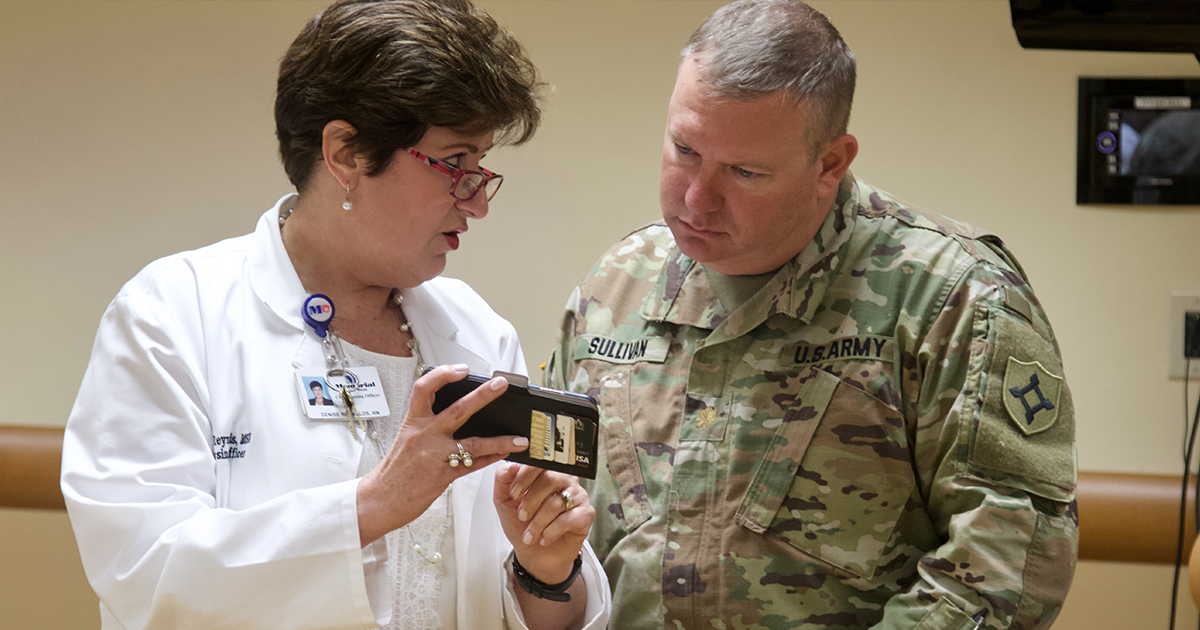This is the second of a series of commentaries proposing an Emergency Green New Deal. The first, “As Workers Fight Coronavirus, They Are Laying the Basis for an Emergency Green New Deal,” describes the need for emergency employment to meet the coronavirus crisis and the economic devastation it is bringing to American workers; tells how worker action on the job, in the community, and in the political arena is already addressing that need; and explains how their action can be the start of an Emergency Green New Deal. This commentary lays out a practical plan for a Green New Deal Work Program that can start right now addressing the emergency needs of the coronavirus era and can develop into a program to provide jobs for all who want them helping fix the damage done by the coronavirus and creating a just transition to a climate-safe economy.

Denise Reynolds (left), the chief nursing officer at Memorial Hospital West, discuss tactics for the coronavirus drive-thru testing facility with Maj. Mark Sullivan (right), with the Florida National Guard’s medical detachment, March 16, 2020. The Florida National Guard is mobilizing up to 500 Citizen-Soldiers and -Airmen in support the Florida Department of Health response in Broward County. Photo Credit: Sgt. Michael Baltz, Wikimedia Commons
On March 19, New York activist and student Erik Forman wrote, “I spent some of today doing deliveries with a volunteer crew of unemployed Uber drivers, mostly to elderly people living in public housing developments.” He asked for a small amount of funds to continue this work and scale it up, and “build momentum for emergency funds to pay for home delivery of meals as a public utility in the crisis.”[1]
That is a microcosm of what we as a society need to do in the face of the coronavirus pandemic – and the economic pandemic that is following hard on its heels. We need to apply the central premise of the Green New Deal – put people to work doing the things we as a society need. It is time to start an emergency jobs program based on that principle. Such a program is necessary to protect against the coronavirus. It is necessary to meet the wave of layoffs that has already begun. And it is necessary to solve the deep crises of climate change and inequality that will still face us when the coronavirus wave eventually subsides.
The coronavirus layoffs have started. According to an NPR/Marist poll, 18% of households have already reported someone being laid off or having hours reduced because of the epidemic. It was 25 percent for those earning less than $50,000.[2] In New Jersey, 15,000 people applied for unemployment benefits on a single day, a twelvefold increase over normal levels; in Rhode Island applications went from 10 one week to 6,282 the next. The U.S. Travel Association projects 4.6 million jobs lost this year in the travel industry alone.[3] Secretary of Treasury Steven Mnuchin warned Republican Senators behind closed doors that without emergency government action the unemployment rate could reach 20% — more like the Great Depression of the 1930s than anything we’ve known since.[4]
In less than a week our government has allocate ed $1.5 trillion to save Wall Street and is proposing another trillion or more for a bailout that will leave most people with nothing except possibly a week’s wages ($1000 per family in Trump’s current proposal) in their pockets. So far the big bucks – trillions of them – are going to protect Wall Street. Programs for fossil fuel and airline industries appear to be on the way. While coronavirus legislation is pending, its main provision to help regular people – sick leave – turns out to exclude 80 percent of workers. Proposals are being made for extended unemployment compensation, healthcare for all, and sending checks to all American families. So far, however, there have been few proposals to deal with the mass joblessness that will follow the pandemic.
When the coronavirus is finally defeated we will face economic devastation that is likely to take years to repair. And we will still face the unrepaired damage of decades of climate crisis, growing inequality, and racial injustice.
We need to start an emergency Green New Deal jobs program – let’s call it a Green Work Program (GWP) — today. We need to put people who are being laid off as a result of the coronavirus pandemic to work wherever they can be safely deployed to help strengthen public health programs, tutor homebound students, prepare and deliver meals to the sick, elderly, and vulnerable, and provide other essential services on an emergency basis. (For some of the work needed right now on an emergency basis that can be performed by laid off workers see “As Workers Fight Coronavirus, They Are Laying the Basis for an Emergency Green New Deal”. We need to start hiring and paying those unemployed Uber drivers who are delivering food to elderly people living in public housing developments. That initial emergency response should become the basis of a GWP designed to provide work for all who need it in the aftermath of the coronavirus. The GWP should be expanded and made permanent as part of the broader Green New Deal plan to address climate change and inequality.
A Green Work Program – What Is It?

Columbus, Ohio. State Hospital. Here the Works Progress Administration (WPA) has a large number of workers who assist in occupational and recreational therapy for patients of the hospital. Photo shows Works Progress Administration women attendants assisting in occupational therapy with the women patients. Photo Credit: Public domain, Wikimedia Commons
Millions were laid off in the early years of the Great Depression. In the absence of programs like unemployment insurance and social security, emergency jobs programs began at the local and state level. Unemployed workers themselves organized self-help mutual aid. Nonprofit organizations started work programs for the unemployed. Municipal and state governments expanded public works.
By 1933, these programs were broke and in collapse. But they offered models and building blocks that where drawn on when the New Deal developed national jobs programs like the Civilian Conservation Corp (CCC), the Civil Works Administration (CWA), and the Works Progress Administration (WPA) that eventually employed more than ten million workers.
Subsequent periods of high unemployment developed similar jobs programs, such as the Comprehensive Education and Training Act (CETA) signed into law by President Richard Nixon during the 1973 recession, which created millions of public service jobs in local government and nonprofit agencies. A key part of the Green New Deal is a similar program, known as a Climate Jobs Guarantee, aka Green Jobs for All or the federal government as “employer of last resort.”
To design the GWP we can draw on analysis of a jobs guarantee that grounded proposals for a Green New Deal.[5] They include a working paper by Pavlina R. Tcherneva of the Levy Economics Institute of Bard College called “The Job Guarantee: Design, Jobs, and Implementation”[6] and the report “The Federal Job Guarantee – A Policy to Achieve Permanent Full Employment” by Mark Paul, William Darity, Jr., and Darrick Hamilton commissioned by the Center on Budget and Policy Priorities.[7]
The GWP will be a federal program somewhat like the New Deal’s WPA that will provide funds for non-profit organizations, local governments, and other agencies serving the public to employ anyone who wants a job at a wage roughly comparable to the demands of the Fight for $15 campaign.
A GWP will provide jobs for all who want them in their own communities performing socially useful work. It will be established by federal legislation, funded by the federal government, and run under the jurisdiction of the Department of Labor or another federal agency. It will be primarily administered by local and municipal governments, nonprofits, social enterprises, and cooperatives. In contrast to the WPA, it is a permanent program, though its size can be expected to vary depending on economic conditions and social needs.
A Green Work Program – How Will It Work?
A GWP can start right now putting people to work to fight the coronavirus pandemic and can then be extended to meet other social needs.
A national GWP will require federal legislation, although smaller-scale experiments can be tried out first at state and local levels. The Department of Labor or another federal agency will host the program and establish guidelines. These should include priority for particular groups such as minorities excluded from the workforce and types of projects like residential energy efficiency.
The GWP will assess needs and resources and match them to people who can work to meet them.
Requests for proposals (RFPs) will invite public, nonprofit, and cooperative agencies to submit proposals. Approved proposals will be listed in a “community jobs bank” for job seekers and will be implemented by the organizations submitting them.
The community jobs banks will find and list available and potential jobs in the communities where they are needed. They will create the greatest number of jobs in communities with the greatest number of people needing work, and will target those groups that have been deprived of fair access to good jobs.
Local agencies will publicize the GWP, especially to those demographics most in need of it. Interested people will be encouraged to visit their local One-Stop Jobs Centers (visiting on-line while the pandemic lasts), which will serve as the information and intake hubs for the GWP. The Job Centers will provide information about GWP opportunities along with other options. Since the program will make jobs available to all applicants, those who accept a GWP job will be hired and go to work.
Training, education, and apprenticeship programs will be designed to meet the needs of program participants, GWP projects, and the wider economy. The program will construct ladders into higher-level employment in the private and public sectors. Participants will be free to leave and seek jobs in private and public sectors. Conversely, those who leave the program will be eligible to return if conditions elsewhere lead them to choose to do so.
The GWP will not exclude any individual or group of people who want to work. It will make whatever special provisions are necessary to employ veterans, at-risk youth, ex-convicts, people with disabilities, and other people with special needs and/or barriers to employment. Like the WPA, it will fit jobs to people, providing employment that is appropriate to their education, skill, and experience. It will provide part-time and flexible work arrangements for those who need them.
The GWP is a new program that does not replace existing programs. People will have a choice between receiving unemployment insurance, welfare benefits, or working under the GJP. GJP is an employment program, not a workfare program that requires people to work in order to receive other benefits to which they are entitled like Medicare, SNAP, or Head Start. It does not displace existing public or private sector work.
The jobs provided by this program will pay an estimated $15 per hour plus benefits, including health insurance. Because it guarantees that every person who wishes to work can find a job with a “Fight for Fifteen” wage and a benefit package, the program will establish a standard that all private, public, and nonprofit employers will have to meet if they want to attract a workforce. It will thus ensure that no worker – whether or not they are in the program –will live in poverty. It will forestall a wage “race to the bottom” in the job shortage that is likely to follow the coronavirus crisis.
The direct cost of providing jobs for all was estimated two years ago at 1.3 percent to 2.4 percent of GDP. The GWP will greatly reduce unemployment, welfare, and other benefit programs, so its net cost at that time would have been somewhere between 0.8 percent and 2 percent of GDP. That’s not counting additional savings from reduced unemployment, substance abuse, health- related costs for uninsured individuals, and suicide.
Let us assume that two years ago the GWP would have cost 1.5 percent of GDP. While we have no way to know how high unemployment will rise in the current crisis, let us assume that it will triple. In that case the cost of providing jobs for all who want them under the GWP will be 4.5 percent of GDP. That would be $1 trillion – less than President Trump and the Senate Republicans are proposing for their upcoming stimulus package.[8] And of course the higher the GWP’s cost, the more money it will put in workers’ pockets and the more economic demand it will create to stimulate overall economy.
Why an Emergency Green Work Program Now?
A Green Work Program is only one part of the Green New Deal. Other elements are also crucial for building a good life after the coronavirus, such as healthcare for all, climate safety through elimination of greenhouse gas emissions, and affordable housing. But putting people to work meeting our common needs lies at the core of the Green New Deal, providing the means necessary for all the rest. What other proposal is as essential to meet our public needs, such as healthcare, climate protection, housing, and many others? What other proposal will go as far to counter unemployment and ensure jobs for all who want them – and especially for the lower-wage workers who are bearing a disproportionate share of coronavirus layoffs? What other proposal would come close to raising our whole impoverished population out of poverty?
The GWP addresses the necessity for providing jobs and meeting social needs in the post-“coronacrisis” era. But it also provides an opportunity to leave behind the unsustainable, unjust, unequal society of the past — to begin building the more sustainable, equal, and just one we want for the future.
The economic crisis that is following the coronavirus crisis is transforming the political context for such a program. Writing in the business magazine Forbes on March 19, soon after President Trump proposed a $1 trillion stimulus package, Senior Contributor Ken Silverstein observed, “The Republicans can no longer argue that they are against government stimulus plans. The only thing they can debate is where to invest the public funds.”[9]
Where can they be invested better than a Green Works Program in a Green New Deal?
[1] Erik Forman, “Support for Gig Economy Workers + High-Risk Seniors,” message to UALE listserve, March 19, 2020.
[2] Rebecca Rainey, “Coronavirus layoffs surge across America, overwhelming unemployment offices,” Politico, March 17, 2020, https://www.politico.com/news/2020/03/17/coronavirus-layoffs-america-unemployment-134819
[3] Rebecca Rainey.
[4] “Mnuchin warns senators of 20% US unemployment without coronavirus rescue, source says,” Reuters, March 18, 2020. https://www.cnbc.com/2020/03/18/mnuchin-warns-senators-of-20percent-us-unemployment-without-coronavirus-rescue-source-says.html
[5] “Climate Jobs for All: Building Block for the Green New Deal,” Labor Network for Sustainability, December, 2018. https://www.labor4sustainability.org/wp-content/uploads/2018/11/LNSpdf_dec2018.pdf
[6] Pavlina R. Tcherneva, “The Jobs Guarantee: Design, Jobs, and Implementation” Levy Economics Institute, April, 2017. http://www.levyinstitute.org/pubs/wp_902.pdf Unless otherwise noted the description of the GJP here is based on the Tcherneva working paper on the job guarantee.
[7] Mark Paul, William Darity, Jr., and Darrick Hamilton, “The Federal Job Guarantee – A Policy to Achieve Permanent Full Employment” https://www.cbpp.org/research/full-employment/the-federal-job-guarantee-a-policy-to-achieve-permanent-full- employment
[8] Ken Silverstein, “Want To Jump-Start The Economy? Include A Green New Deal In The Stimulus Package,” Forbes, March 19, 2020. https://www.forbes.com/sites/kensilverstein/2020/03/19/want-to-stimulate-the-economy-include-a-green-new-deal-in-the-coronavirus-bill/#d9f7b7f43861
[9] Ken Silverstein.

